I first experienced Benson Polytechnic High School in 2007. I began working on its modernization project a decade later, then the 2017 Portland Public Schools (PPS) bond (partially) funded the reconstruction. As the new design nears completion, and with construction including substantial demolition slated to begin later this year, I have explored the history of the school through its buildings.
1916 Master Plan
Benson fills a six-block campus in inner northeast Portland. Extensive career-technical-education programs present a unique collection of building uses, from manufacturing shops to healthcare-education clinics. The original main building, boiler house, north shops, and foundry building date to 1916. The corresponding master plan envisioned a series of neoclassical brick building “units” separated by courtyards. Single-loaded corridors connected the units and defined a large eastern athletic courtyard.

By 1930, a south shop wing, gymnasium, and auditorium building were completed to the general layout of the original master plan by F. A. Naramore. A 200-foot-tall school-operated radio broadcast tower was erected in that same decade. While the permanent structures maintained the original massing and circulation pattern, dozens of temporary learning spaces began to fill the open courtyards. Despite the expansive building footprints, usable space on the now-urban site became constrained.
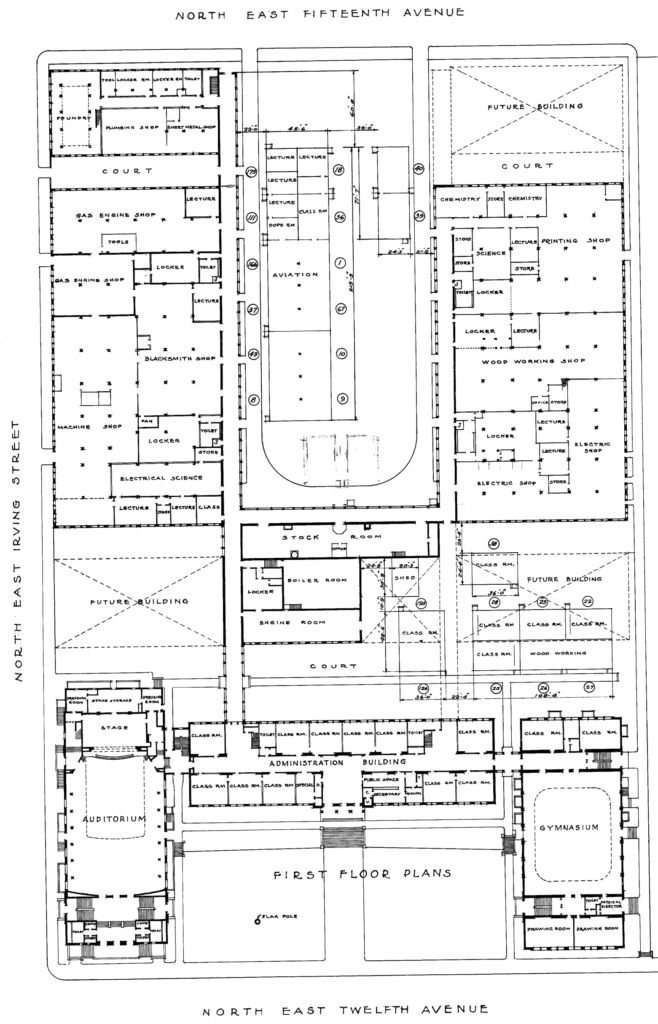
The Post-War Construction Boom
Demand for additional capacity spawned a flurry of school construction throughout Portland following World War II. At the Benson campus, two 1953 buildings dismantled the original parti of wings connected by single-loaded corridors and separated by open courtyards. The Library & Science building was placed far too close to the original administration building, whose east brick façade was stripped of its wood windows and coated with paint. The Automotive & Aeronautics building and a parking lot filled the east athletic courtyard, turning the eastern half of the campus into an asphalt-filled sea of dark, auto-oriented, single-story structures. Inside, historic flooring and ceiling surfaces were covered throughout the campus.
Alterations by the same architect continued into the one-story shop wings in 1958 and 1960, where sawtooth roof trusses with skylights were covered or removed, heavy timber columns were replaced with steel and CMU, low dropped ceilings confined the spaces, and numerous original windows were infilled. The 1964 tilt-up gymnasium was the final significant project of the post-war era. In addition to its incompatible exterior that remains unsightly today, its construction literally stripped the original brick and terra cotta ornamentation from the east facades of the 1916 administration and 1925 gymnasium buildings to create a flat interior wall. However, it used the only remaining open space on campus that could fit this program.

Late 20th-Century Evolution
1977 renovations forever changed the 1916 foundry building’s interior, infilling double-height spaces, removing solid tongue-and-groove wood partitions, flattening sawtooth roof skylights, and restructuring the heavy timber floor and roof. The exterior remained historically-intact other than the addition of two CMU stair towers, later joined by an elevator and covered walkway, to the west façade.

The dozen present buildings were completed with the 1991 construction of a freestanding radio broadcast building and a library & health sciences wing, along with a small music room structure and minor alterations throughout the buildings. The library building features a timely postmodernist interior complete with glass block and clerestory atriums. But its massing is flawed, with a bizarrely-shaped basement, oversized first floor, and short, minimally-windowed upper level. Its design was surely driven by field conditions, many of which could have been avoided with a design following the original campus master plan calling for light courts between each wing. Instead, this addition covered two more original 1916 facades. The 1930 Auditorium building’s rear façade was also obscured, as part of the new second story extended over its east low roof, a bay of the 1930 brick veneer was replaced with new brick to match a flush new wall, and the original organ was removed (and re-installed at Cleveland High School). Structural challenges and the library building’s inappropriate connections to no fewer than five distinct previous buildings, ultimately led to its planned demolition — a cost savings relative to a retrofit scheme.
Present Condition
The modernization project team has spent more than two years studying the present condition of Benson’s buildings. Discoveries on site, in the as-built drawings, and through structural analysis have informed decisions from replacing the 1991 media center to structurally retrofitting the radio tower. Input from the Portland Historic Landmarks Commission influenced a final design that alternates new brick-clad buildings with historic facades around the full perimeter of the site. The following galleries, collected between 2017 and 2021, document the existing conditions that will soon transform with the modernization project.
Building Exteriors


With its placement on a gradual uphill slope across from low-rise industrial buildings, the Benson campus is prominently visible when viewed from the west. 
West entry courtyard on a winter morning. 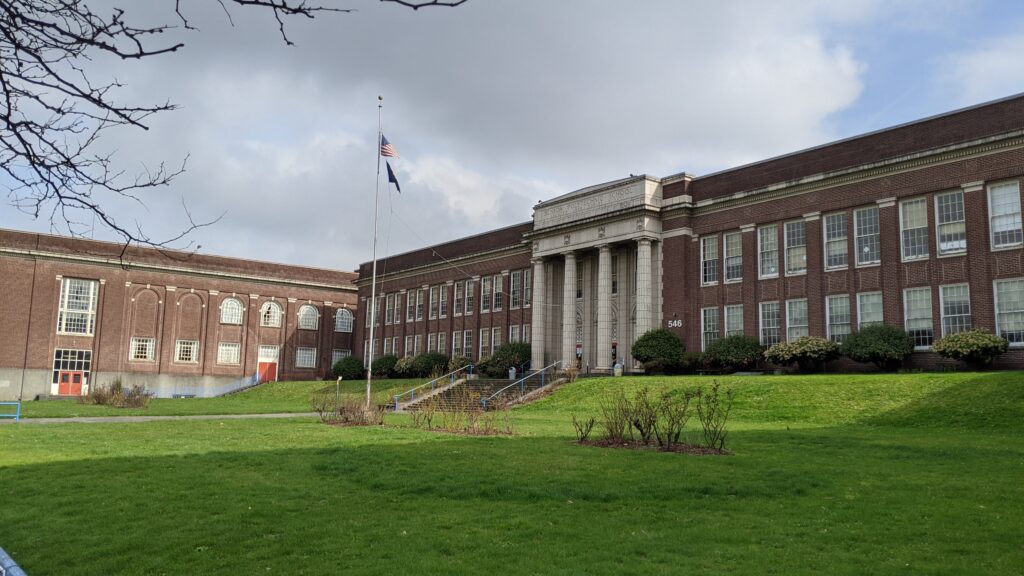
The historic west entry courtyard from the SW. 
West façade of the 1916 administration building. 
Three main entry doors to the 1916 administration building each feature a unique terra cotta tympanum showcasing the industrial arts taught at Benson Polytechnic School. 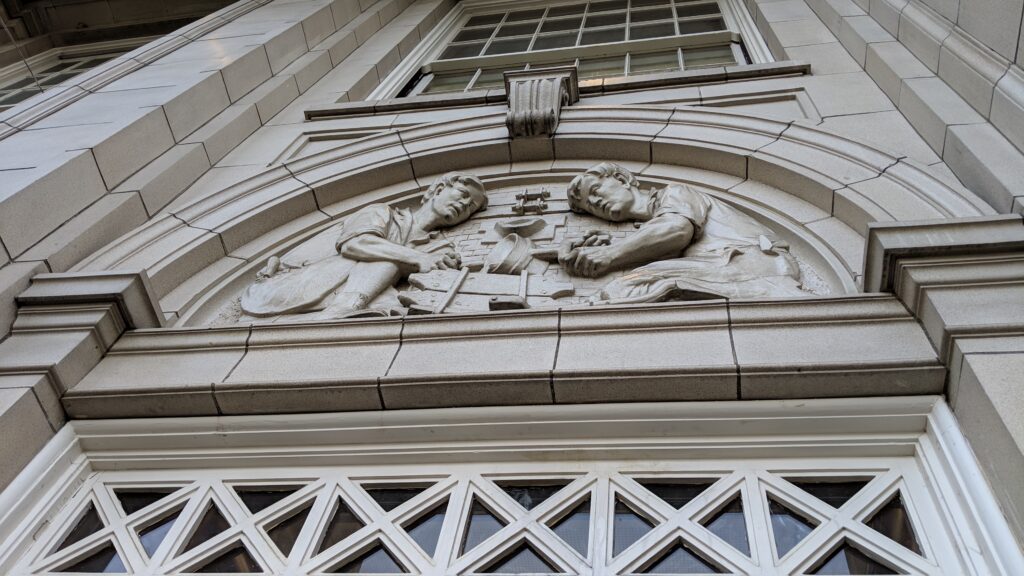
Terra cotta tympanum over the south main entry door. 
Terra cotta tympanum over the center main entry door. 
The terra cotta tympanum over the north entry door. 
Terra cotta columns support a large entablature mass standing proud of the west wall of the main entry to the 1916 administration building. 
An oblique view of the main entry at dusk. 
The west façade of the 1916 administration building at dusk. 
A single-level brick passageway, with an outdoor second-story corridor, connects the 1916 administration building to the 1925 gym. 
Flowering shrubs line the base of the 1916 administration building. 
A cornerstone commemorates the 1916 construction of the administration building, listing the board of directors and school architect. 
A recessed connection defines the clear separation between the 1930 auditorium and 1916 administration buildings. 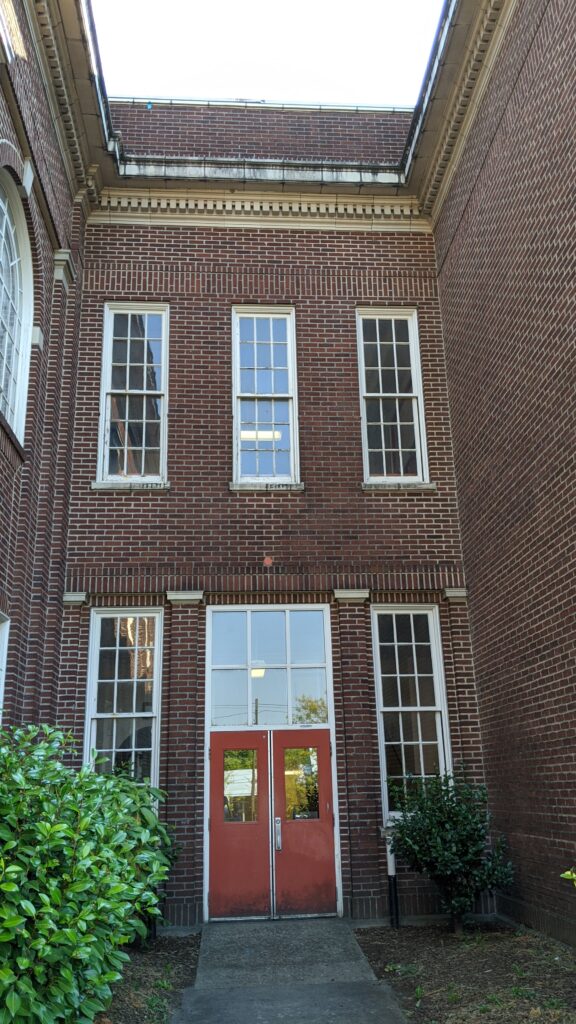
Unlike the open-air south connector, the north passageway between the 1916 administration and 1930 auditorium buildings is a two-story mass. 
Brick and terra cotta articulation on the 1930 auditorium building where it meets the connecting passage to the 1916 administration building. 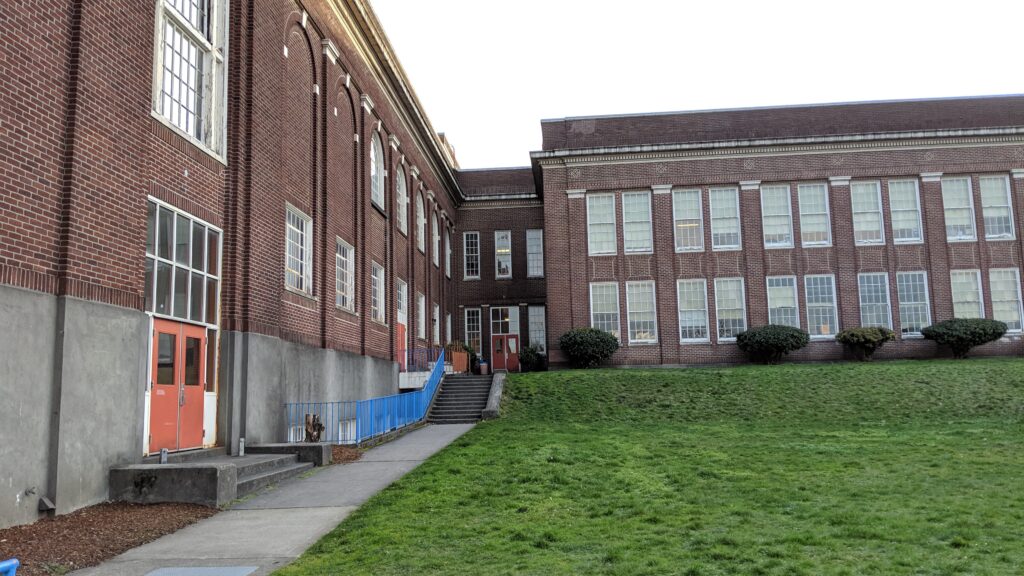
A nondescript walkway lines the north edge of the historic west courtyard along the auditorium building. 
The west side of the 1930 auditorium building features terra cotta stairs and a balcony leading to the historic theater lobby. 
Terra cotta and brick cladding with wood windows at the west entry to the auditorium building are arranged in a unique pattern differentiated from the rest of the campus. 
The west entry to the 1930 theater lobby features a solid triple-level mass of terra cotta with detailed ornamentation. 
North façade of the 1930 auditorium building along NE Irving St. 
Staircases and railings line the public realm along the north face of the auditorium building. 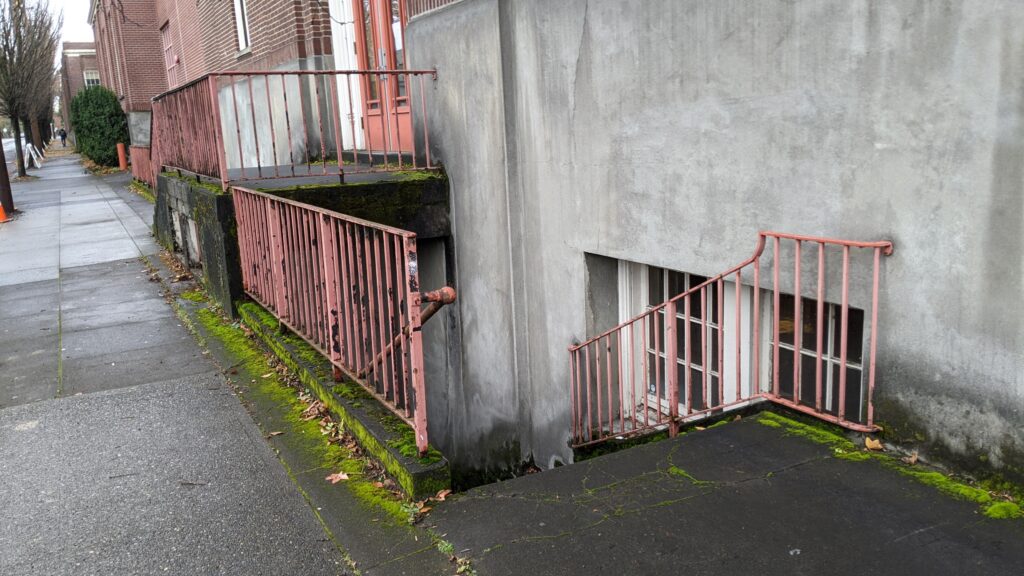
Stairs to the auditorium and the basement cafeteria along NE Irving St. 
The 1991 library building successfully “floats” below the large historic cornice wrapping the 1930 auditorium building. 
1991 brick flush with the library building’s wall disguises the original form of the 1930 auditorium building, with its eastern low roof. 
The 1991 library building mimics the historical architecture with similar brick colors and a brick replica of the terra cotta cornice. 
The 1916 north shop wing overlooks NE Irving St. with a tall concrete plinth due to the slope across the multi-block campus. 
The 1991 library addition meets the west side of original 1916 north shop wing with a single-window setback from NE Irving St. 
Brick and terra cotta details on the north façade of the 1916 one-story shop building. 
Portions of the historic building exteriors are in need of significant cleaning and repair to avoid further deterioration. 
The exterior-facing facades of the 1916 north shop wing feature similar articulation to the two-story buildings. 
Brick cladding sits on a variable-height concrete base throughout the historic buildings. 
1977 CMU Stair towers are applied to the west face of the 1916 foundry building. 
1916 brick and 1977 CMU detail at the west edge of the foundry building. 
West façade of the foundry building where white-painted CMU additions meet the original 1916 brick. 
The two-story 1916 foundry building anchors the NE corner of the campus with no setback along NE 15th Ave. 
Decorative brickwork surrounds a fan light transom over a door at the east end of the original connecting passageway mass along the foundry building. 
Sunlight accentuates the brick articulation of an intact portion of the original fan-light-lined passageway connecting the north shop wings. The rooftop dust collector reveals the building’s interior use as a shop. 
Driveway between the 1953 automotive & aeronautics building (left) and the 1916 north shops & foundry (right). 
The mostly-blank stucco walls of the 1991 library building rise behind the corner of the original fan light windows lining the east courtyard. 
An enlarged fan light window defines a secondary entrance to an original passageway mass along the east edge of the 1916 boiler house. 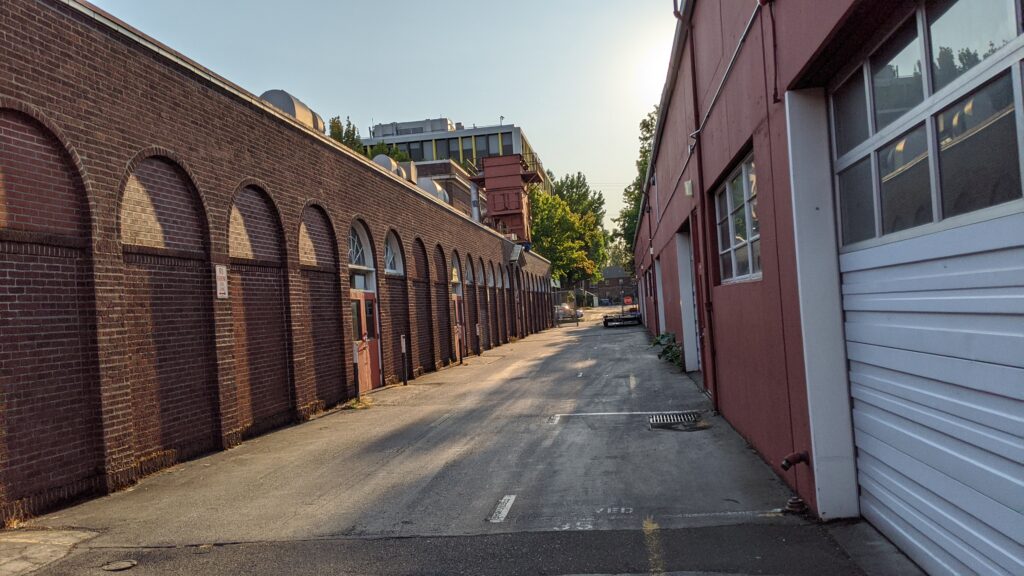
The long, original 1916 passageway volume (left) currently overlooks a driveway and the 1953 automotive building, although many of its windows were infilled in 1958. 
A brick pediment with terra cotta cornice defines an entry along the 1916 single-story fan-light-lined passageway that encircles the east courtyard. 
East façade of the 1953 automotive & aeronautics building along NE 15th Ave. 
The east façade of the 1953 automotive & aeronautics building features large windows overlooking NE 15th Ave. 
Driveway between the 1991 KBPS (left) and 1953 automotive (right) buildings, with the 1918 south shops at back left. 
A fire lane and ivy-covered hillside separate the 1918 south shop wing from Buckman Field. 
Bricked-up openings in the 1918 south shop wing include two arched “entry” bays that are planned for restoration. Reflected bays on the 1916 north shop wing were squared off in 1958. 
Trees cast intricate shadows on the south façade of the 1918 shop wing. 
Bricked-up openings and small replacement windows disguise the craftsmanship evident in the historic 1918 south shop building’s façade. 
The base of the radio tower sits at the SE corner of the 1918 south shop building facing Buckman Field. 
Mature camellias anchor the corner of otherwise-unadorned 1964 gym building. 
The 1964 gym building features integrally-colored (reddish) tilt-up concrete walls framed by cast-in-place (gray) concrete beams and columns. 
The south façade of the 1925 gym features arched steel windows over the interior running track mezzanine. 
A row of mature camellias create a soft base for the 1925 gym building, except when they are severely pruned every few years. 
South façade of the 1925 gym. 
A large divided light wood window, in need of restoration, brings daylight into the stairwell and corridors of the 1925 gym. 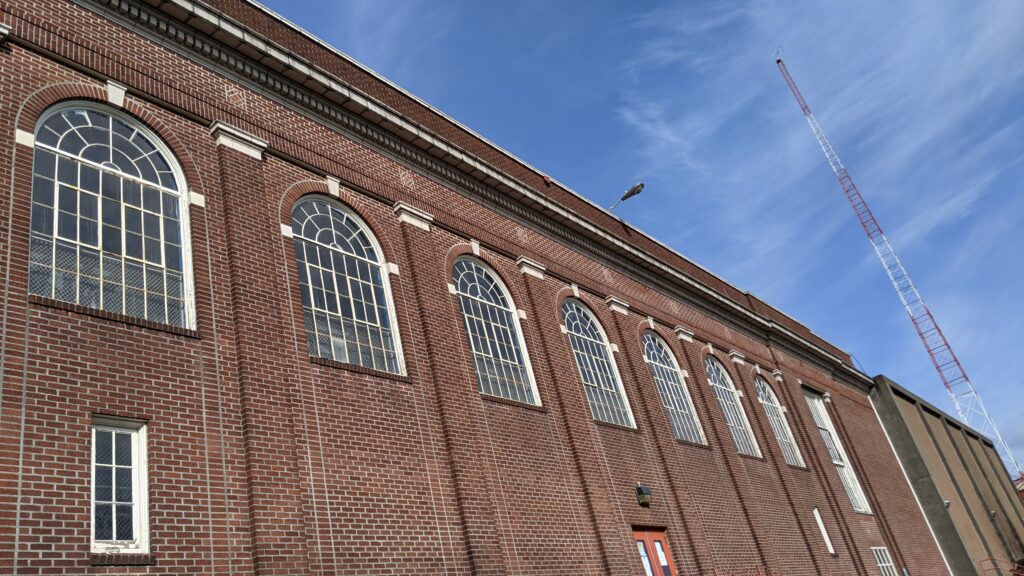
The ornamented brick and terra cotta 1925 gym contrasts with the monolithic concrete 1964 gym, further contrasted by the radio tower. 
Large windows at an “entry” bay on the south façade of the 1925 gym building define what is not, but will become, a stairwell. 
South façade of the 1925 gym, the 1964 gym, and the radio tower. 
The typical facade articulation on the original buildings includes paired windows with two sizes of brick pilasters, creating a strong vertical rhythm and 8″ of variation in brick thickness. 
Trees soften the west façade of the 1925 gym along NE 12th Ave. 
Flowering Pieris shrubs add texture to the public realm at the base of the 1925 gym building along NE 12th Ave. 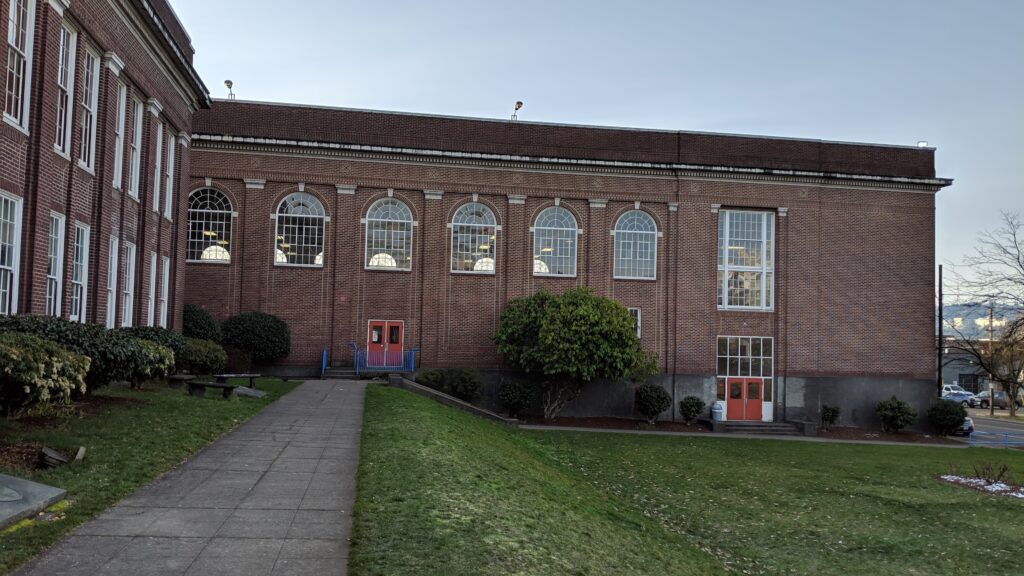
The north façade of the 1925 gym approximately reflects the north and south facades of the 1930 auditorium building. 
Windows along the north face of the 1925 gym allow views across the running track and out the opposite windows to Buckman field, while reflecting towers from the Lloyd district. 
The terra cotta cornices lining the historic buildings feature dentil molding and pine cones at the corners of entry bays, a nod to benefactor Simon Benson’s role in the timber industry. 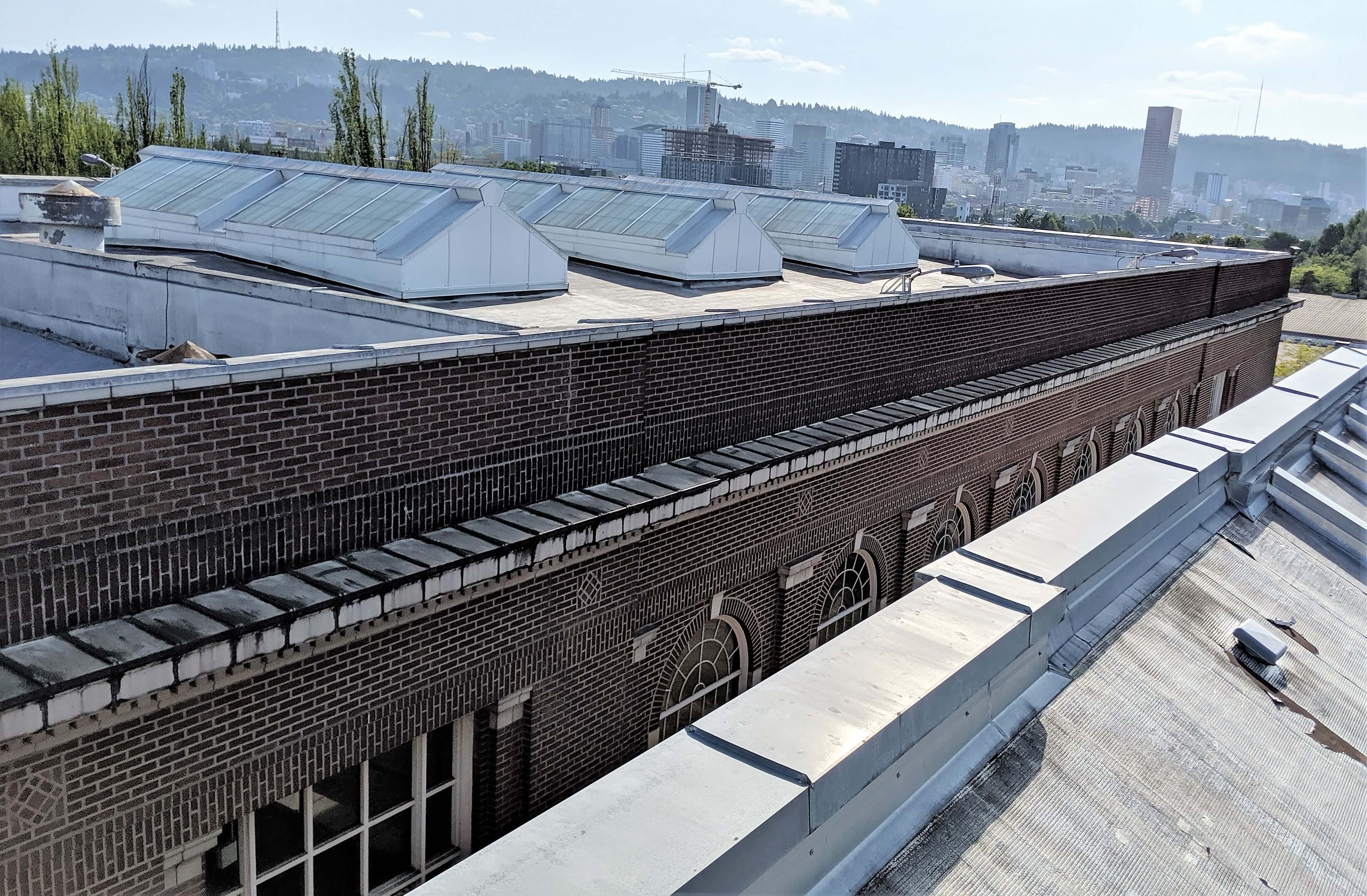
A view over the roof of the 1925 gym building toward downtown Portland. 
The 1964 gym’s roof meets the brick spandrel of the 1925 gym building where the terra cotta cornice was originally located. 
The 1953 library & science building created a narrow light court, viewed here form the 1964 gym’s roof. The 1916 administration building’s wood windows were replaced and its brick piers were painted to match the newer building in 1953. 
The 1953 paint was successfully removed from the east façade of the 1916 administration building as part of an early work package in summer 2020. The windows will be replaced later in the modernization project. 
A collection of several additions fills the center of the campus surrounding the 1916 boiler house. Note the anchor rods projecting from the 1953 library & science building (left), where a second-story addition over the older buildings was once planned. 
Several one-story shop buildings separated by an asphalt parking area fill the east portion of the campus. The tall roof of the north shop building (left) conceals its original sawtooth roof trusses. 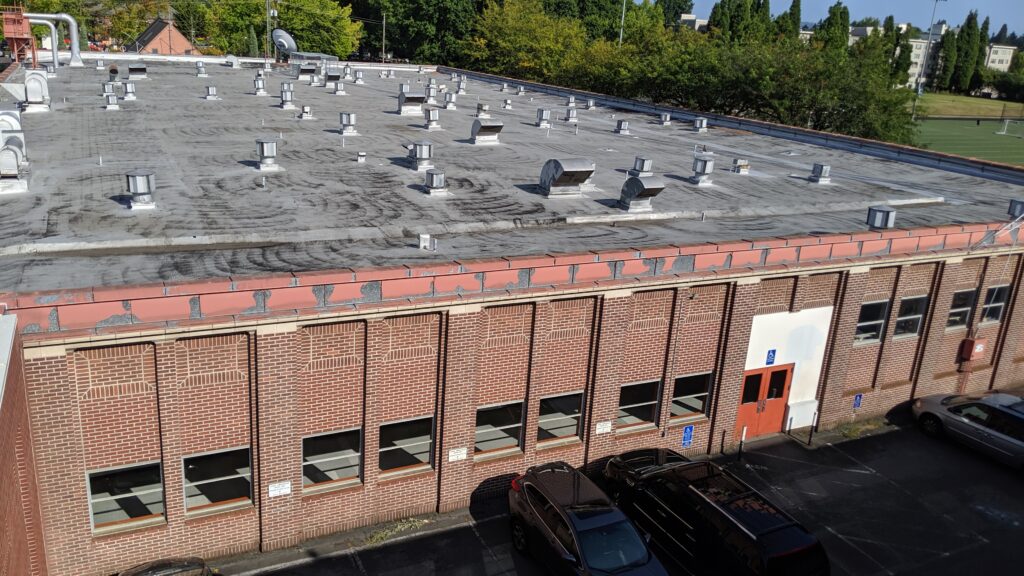
The south shop building was heavily modified in 1960. The original sawtooth roof is now flat. The west façade seen here features windows approximately half the height of the originals. 
The KBPS radio tower. 
The 1991 KBPS radio broadcast building is oriented to NE 15th Ave with a dedicated entry.
1916 Administration Building


Decorative wood pediment over a side door in the main entry lobby. 
Display cases line the intersection of the historic main entry lobby and the main corridor. 
Wood paneling in the historic main entry lobby. 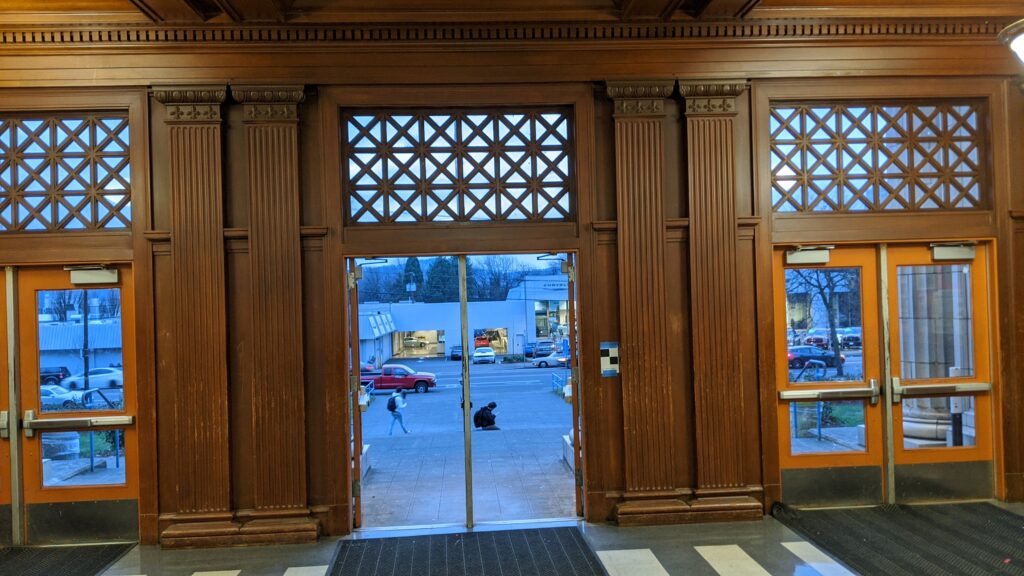
West wall of the historic lobby looking out to NE 12th Ave. 
Historic wood and plaster coffered ceiling in the main entry lobby. 
Historic main corridor in the administration building. 
While most of the historic wood trim has been painted, elements remain stained at the historic staircases in the administration building. 
Tall east-facing windows, replaced in 1953, bring light down the historic staircases to the main corridor in the administration building. 
Skylight and transom relite at an upper stair landing in the administration. 
View down the second-level corridor in the administration building, looking toward the gyms. 
View to exterior doors at the outdoor “bridge” element linking the upper levels of the administration and gymnasium buildings. 
A second-floor connecting corridor shows a sharp shift in character between the 1916 administration and 1953 library & science buildings. 
A series of five historic skylights coupled with tall ceilings make the second level corridor in the administration building bright and open. 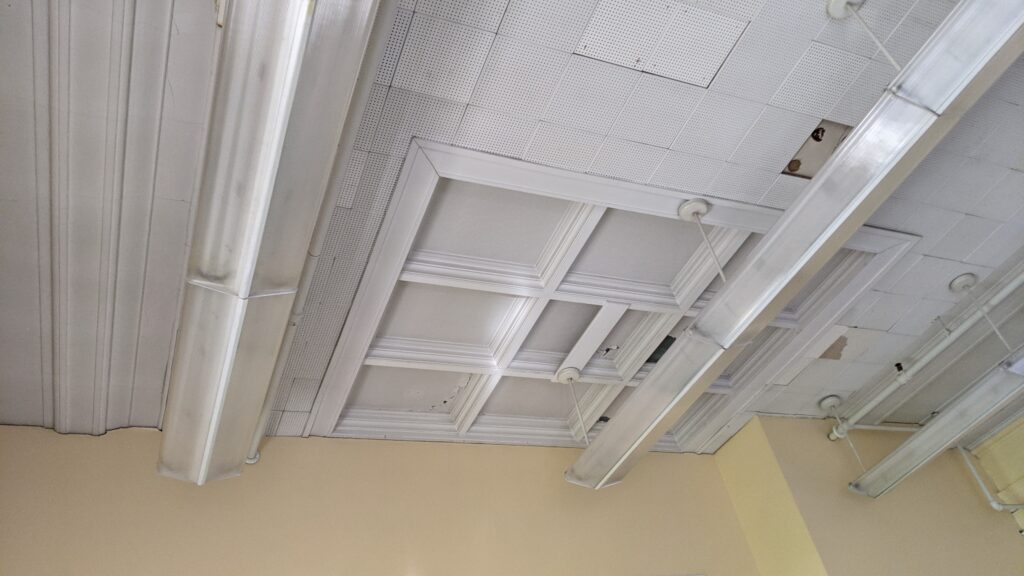
Decorative plaster cornices and a painted-over skylight offer glimpses of the once-grand character of the space that originally served as a library above the main entry lobby. 
Large windows in the historic stairwells currently look out to the largely-blank failing-painted-concrete walls of the 1953 library & science building.
1930 Auditorium Building
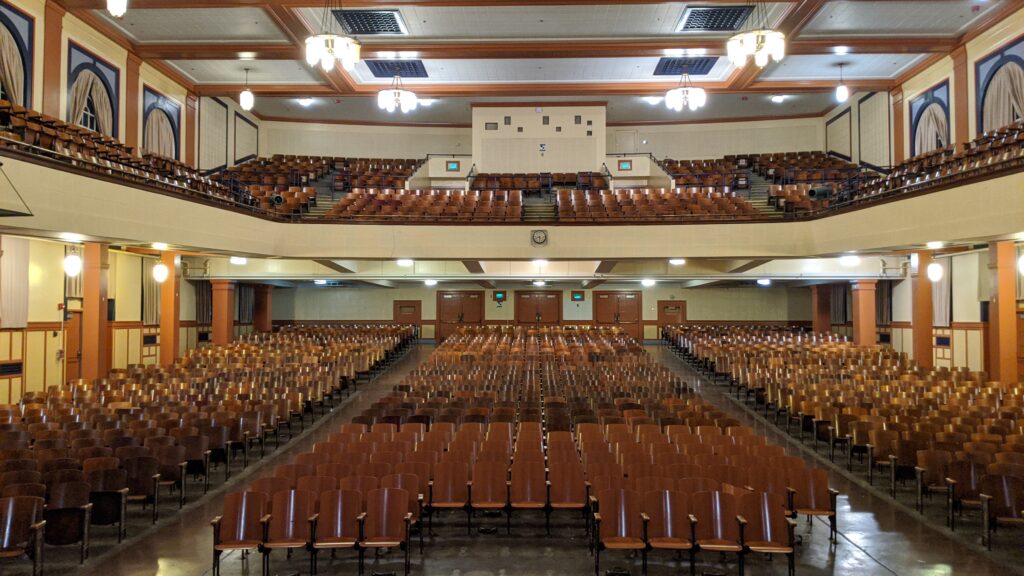

An original arched cased opening – unique to this location on the campus – originally led to an exterior door where the 1991 media center is currently located. 
An historic staircase between the administration and auditorium buildings is slightly less decorative than others found on the campus. 
South seating section below the balcony viewed from the stage. 
The curved face of the balcony features limited theatrical lighting equipment and acoustical tile over historic plaster. 
Historic decorative plaster proscenium and speaker enclosure. 
View to the stage from below the balcony at the back of the auditorium. 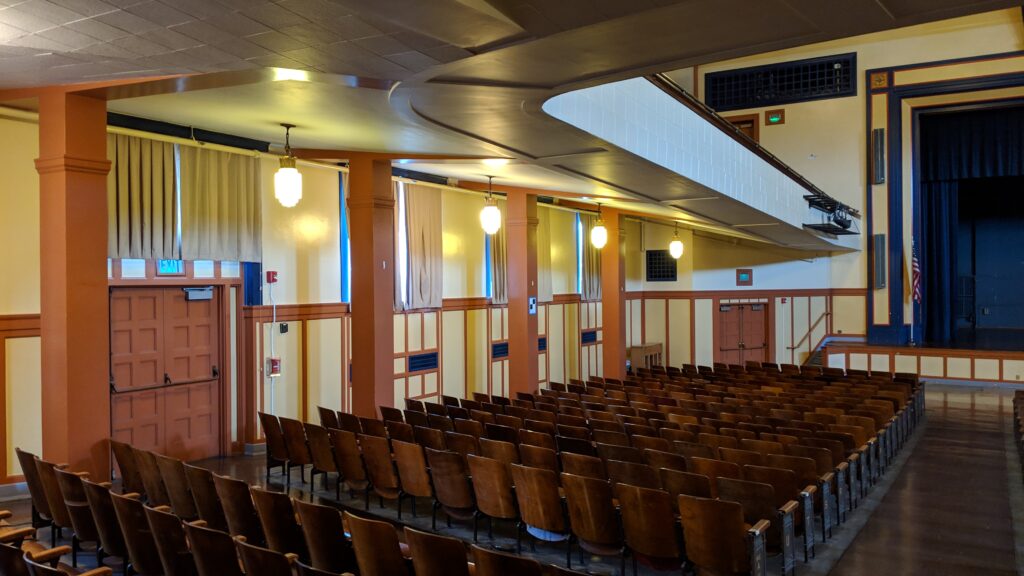
Auditorium north seating section below the balcony. 
Historic decorative plaster ceiling details conceal a massive riveted steel truss supporting the balcony. 
Decorative plaster beams and historic chandeliers below the balcony. 
Rows of historic wood seats in the auditorium. 
“Mushroom” vents under the seats distribute air from the mechanical system. 
Historic auditorium seats and concrete and cork flooring. 
The historic theater lobby features an exterior and interior procession of stairs up from the street. 
The theater lobby features original wood paneling and terrazzo floors. 
The theater lobby ceiling features glued-on acoustic tiles, now falling off, similar to most historic ceilings across the campus. 
Wood paneling and glazed transom in the theater lobby. 
Decorative wood and plaster elements in the theater lobby. 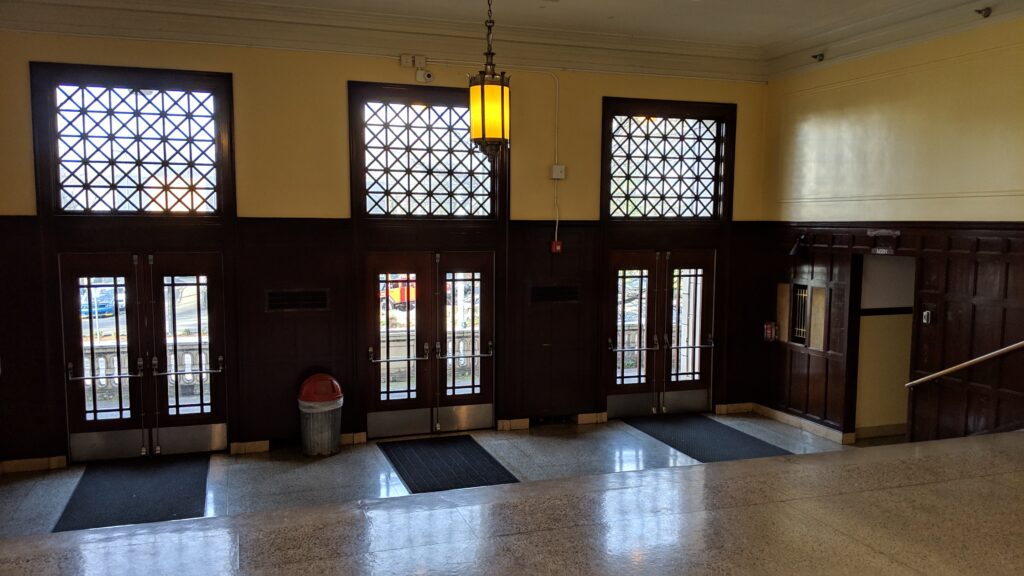
Historic theater lobby. 
Historic theater lobby and staircase. 
Light fills the theater lobby and staircase through large, original divided light wood windows. 
View of the administration building through an historic wood window in an auditorium building stairwell. 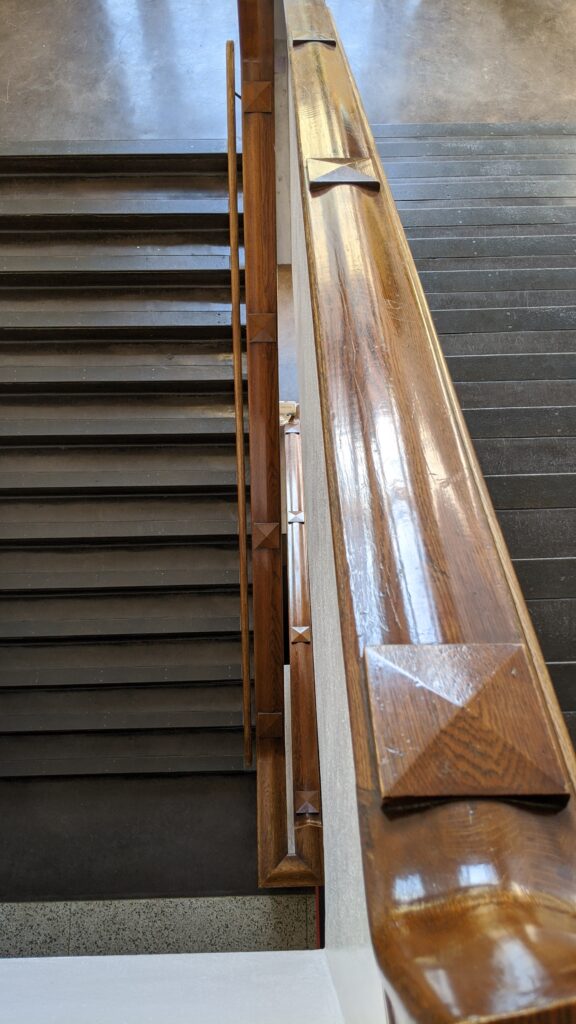
Oak caps with anti-sliding articulation wrap down three levels of a staircase in the theater building. 
The upper-level theater lobby is currently used as additional flex space for the adjacent classrooms. 
Historic 1930 double windows line the original radio broadcasting room in the auditorium building. 
Stage view from the center of the balcony. 
Balcony seats. 
View across the auditorium from the south side balcony. 
Stage view from the back of a left side balcony. 
A large percentage of the auditorium’s seats are in the upper balcony. 
Upper balcony seating area in the auditorium. 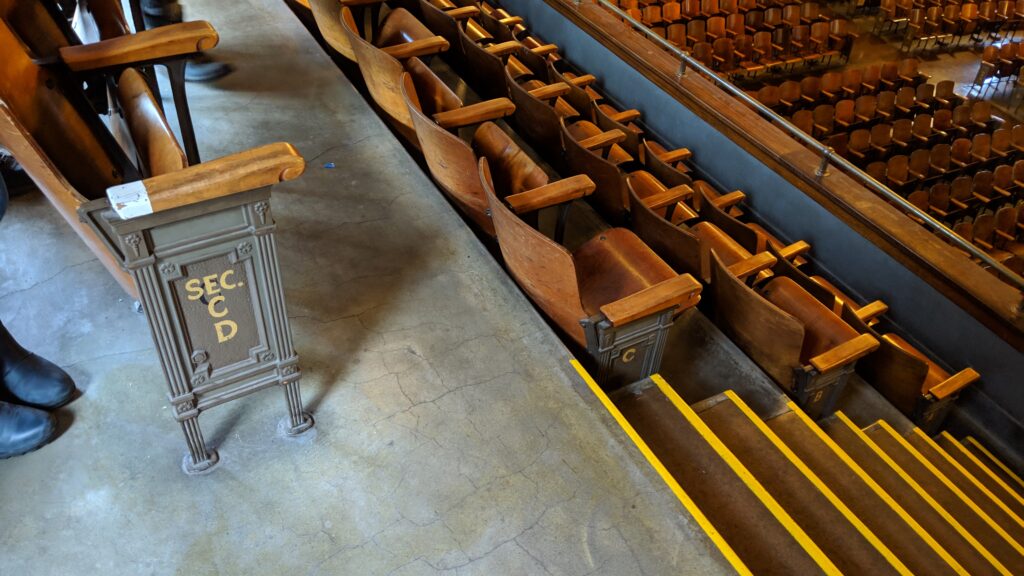
Metal-supported wood seats along the steep side balcony in the auditorium. 
Balcony seats viewed through a decorative wood grille from a former organ loft hidden behind the proscenium. 
Historic chandeliers and decorative plaster ceiling (with applied acoustical tile) in the auditorium. 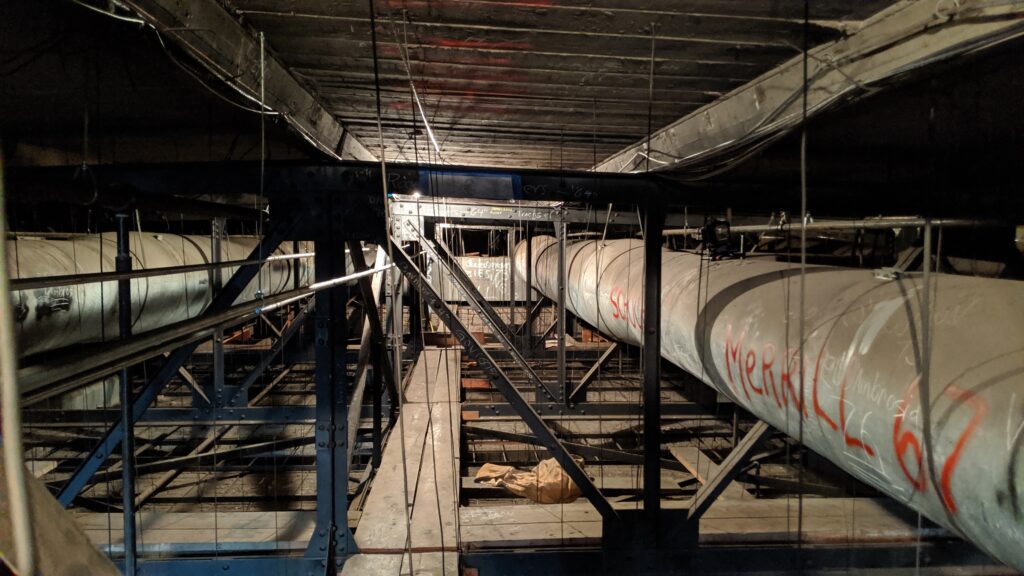
Hidden above the historic auditorium theater, a network of mechanical ductwork weaves through riveted trusses supporting the concrete roof. 
High above the stage, the gridiron features theatrical rigging equipment and lots of graffiti. 
Original wood doors and trim between the theater balcony and an exit stair. 
A remote stairwell on the north edge of the auditorium is one of the few places on the campus that still features all-original stained wood trim, doors, and windows. 
One of the view remaining original pairs of wood exterior doors is located north of the stage, complete with sidelights and transom. 
A wide staircase connects the theater lobby to the main entry courtyard. 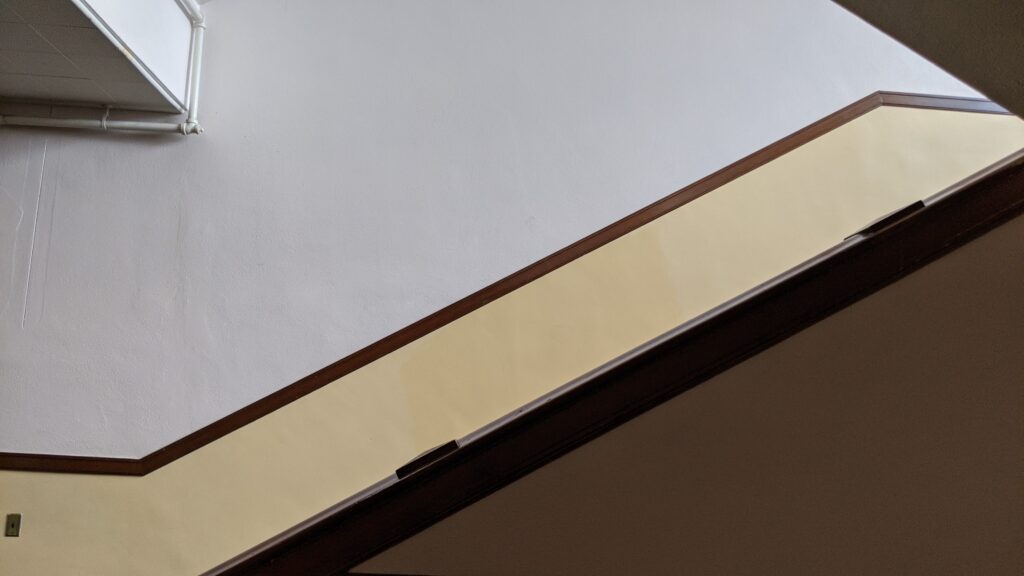
Wood picture rails slope to match the oak-capped guardrails at the historic stairs. 
The basement below the auditorium serves as the cafeteria space, last renovated in 1991. 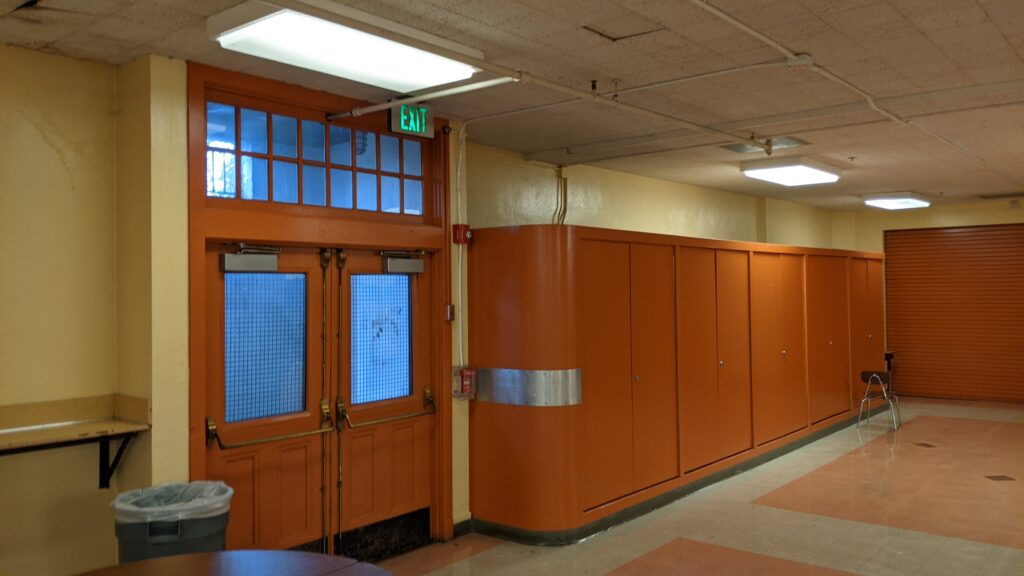
Doors to an exterior exit stair and built-in cabinets in the basement cafeteria. 
The cafeteria windows in the lower level look out to light wells, with a slight view to the campus main entry from this angle. 
The lower level auditorium lobby is currently a crossroads between a mechanical room and the cafeteria. 
A massive, original fan hidden below the historic lobby circulates air for the auditorium building. 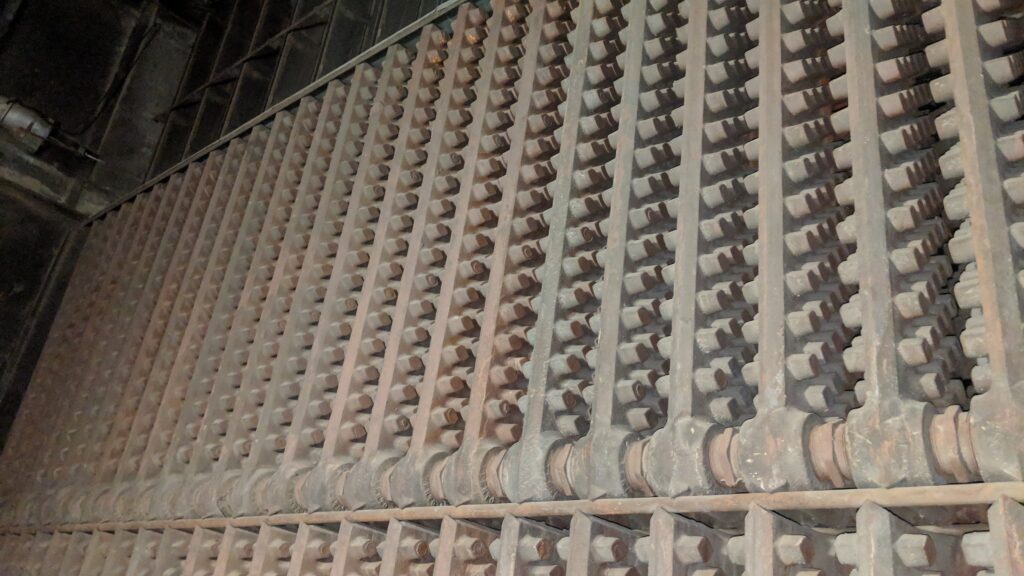
A massive radiator services the auditorium from below the historic theater lobby.
1923 & 1964 Gymnasiums
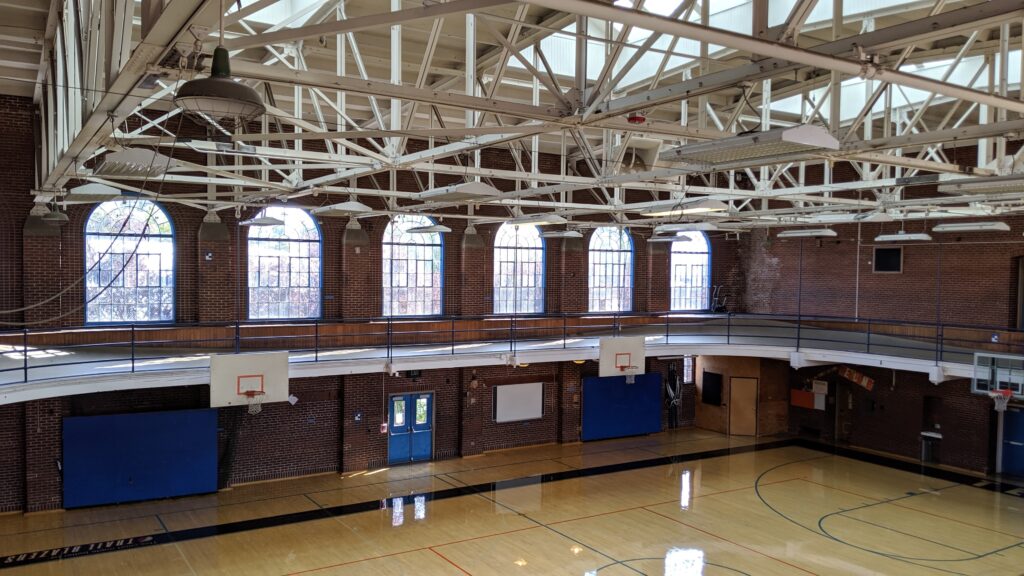

The main corridor accessing both gymnasiums is part of the older 1925 gym building. 
The 1925 gym features a banked running track mezzanine level. 
A remote corridor with access to classrooms west of the 1925 gym features a large relite at the stairwell. 
Wood roof joists, attic hangers, and cross bridging support the classroom wings flanking the 1925 gym. 
Space for building services behind the historic brick walls of the 1925 gym. 
An unusually-shaped speaker “horn” is suspended in the corner of the 1925 gym. 
Skylight gable roof, steel trusses and bridging, arched windows, exposed brick, and the suspended running track mezzanine add a unique character to the 1925 gymnasium space. 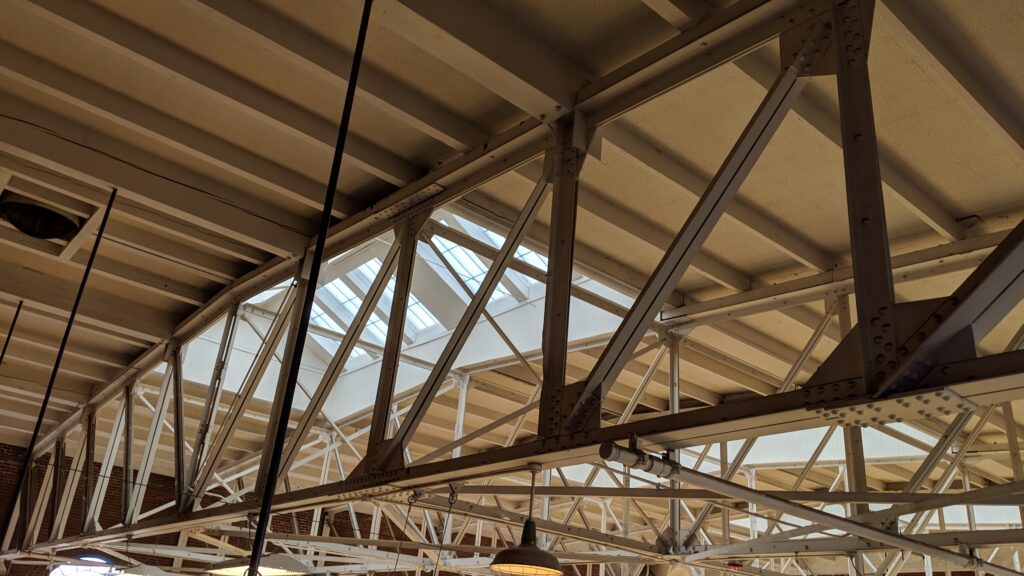
Riveted steel roof truss in the 1925 gymnasium. 
Skylights and steel roof trusses in the 1925 gymnasium. 
North interior façade of the 1925 gym. 
The wood running track structure is supported by the brick walls and steel hangers from the roof trusses. The gym interior brick features common bond, in contrast to the running bond found throughout the campus’ exterior walls. 
Stripped paint reveals the original wood grain of structural beams supporting the running track mezzanine. 
The large arched windows result in a drastically different experience in the 1925 gym after dark. 
Roof trusses and skylights in the 1925 gymnasium. 
A staircase in the 1925 gym building features a curved wood-capped guardrail. 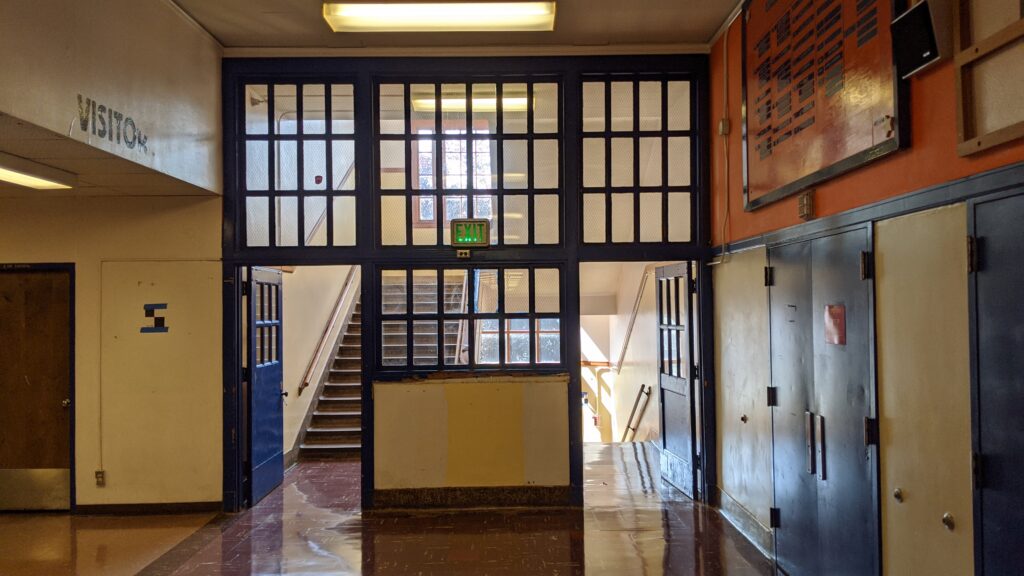
A large relite defines the entry to a staircase at the end of the primary gymnasium corridor that extends from the administration building axis. 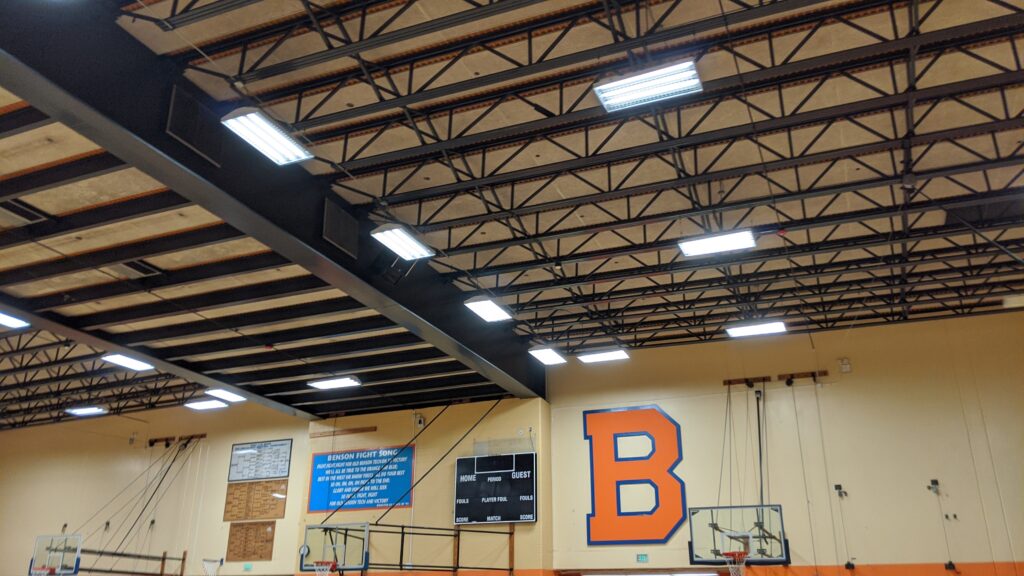
The 1964 gym features one large double-height room with exposed roof structure. 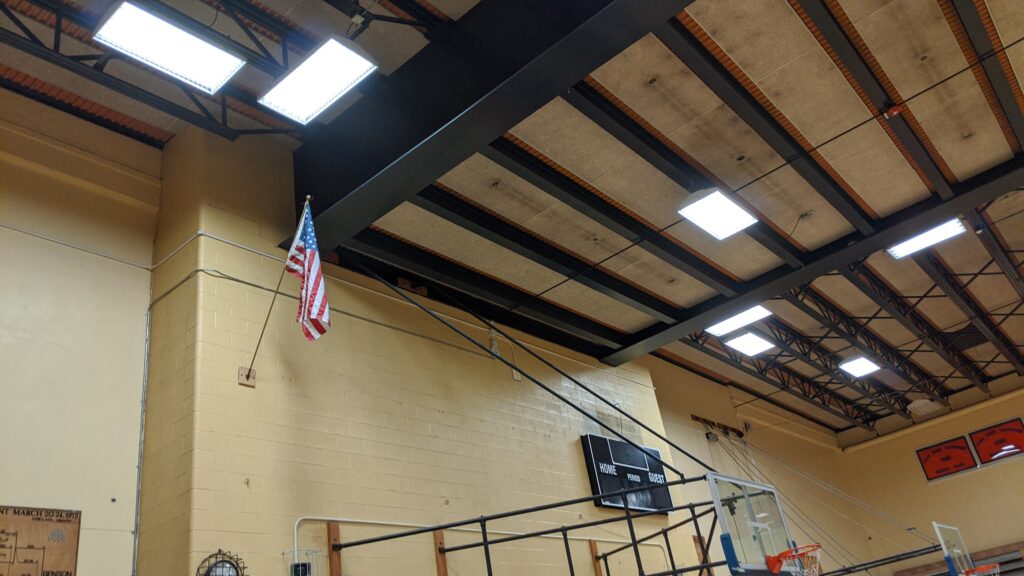
The 1964 gym attaches to the east walls of the 1925 gym building and the 1916 administration building. While most of these facades’ articulation was removed or covered in plaster, the original decorative spandrels are masked only by paint on either side of the CMU plenum. 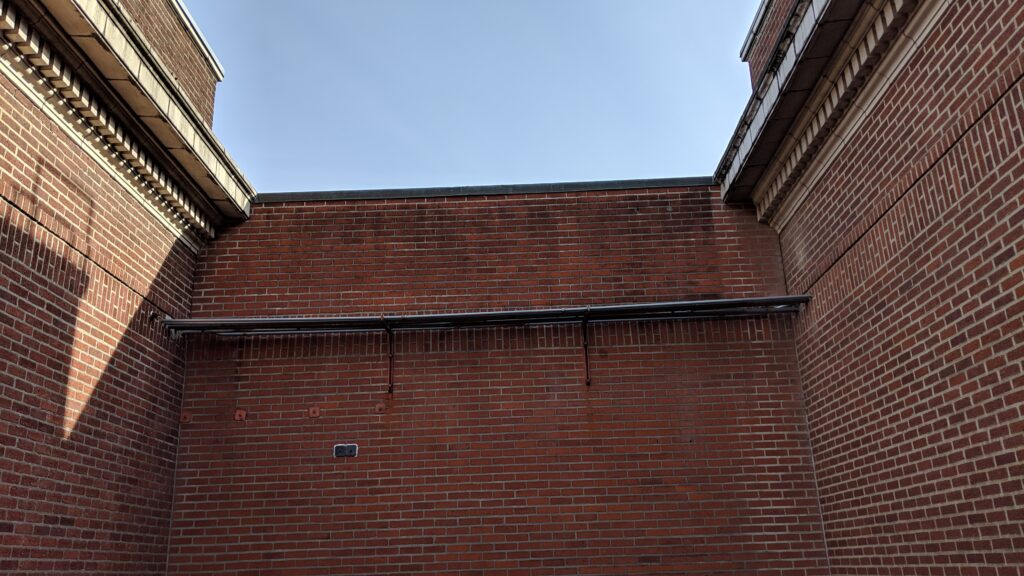
A brick wall for the 1964 gym building spans the original gap between the 1916 administration and 1925 gym buildings.
1916 – 1960 CTE Shops

The long, dark central corridor in the south shop wing was installed in 1960. 
Only one original single-loaded corridor is presently intact with its original use, seen here at the east edge of the 1916 boiler house and 1930 addition. Note the fan light windows, brick wainscoting, and exposed wood roof decking (now lined with building services). 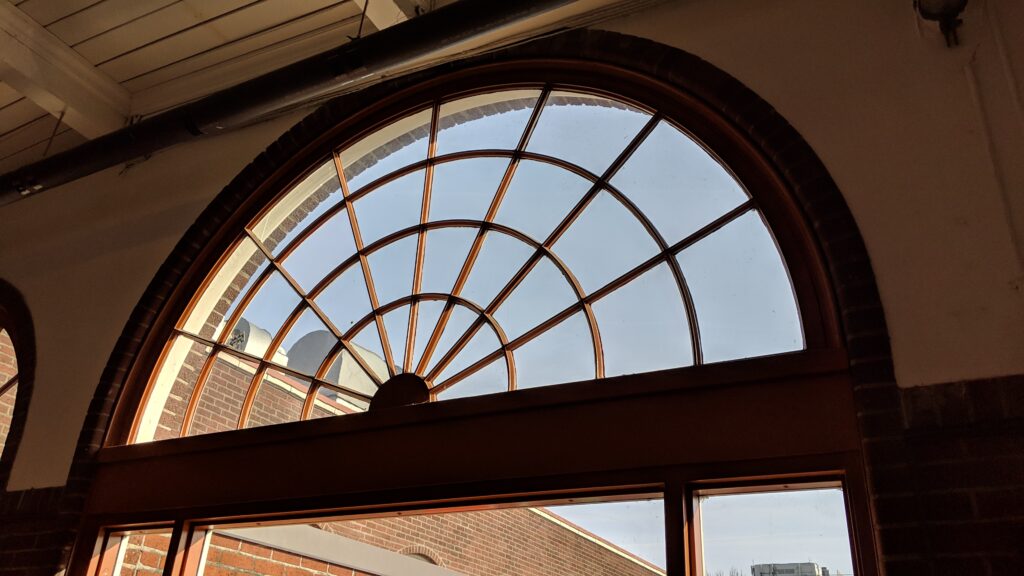
Interior of a large fan light window over an original entrance to the 1916 boiler house. 
A construction shop in the north one-story shop wing. 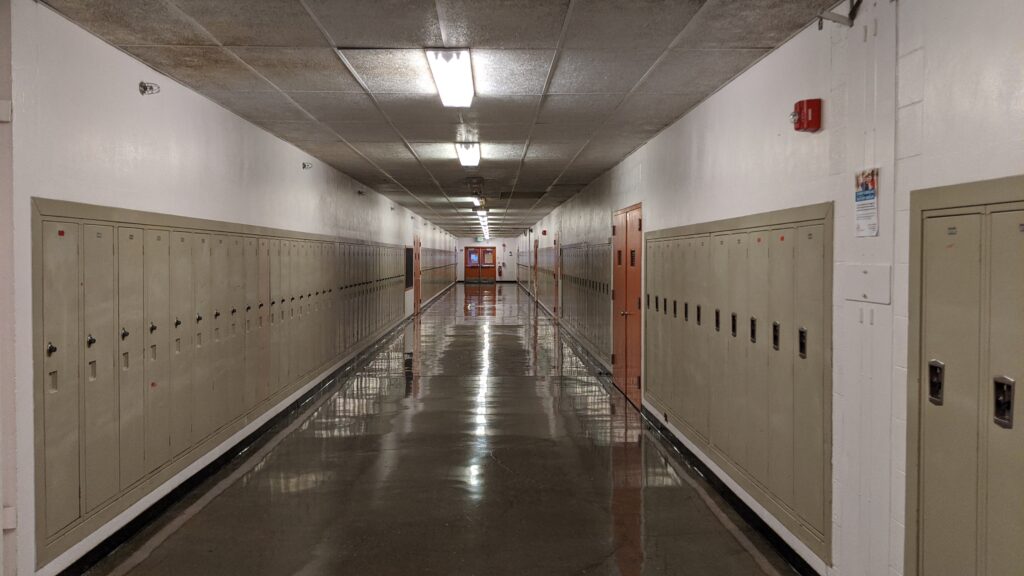
This long, dark corridor has run down the center of the north shop wing since 1958. 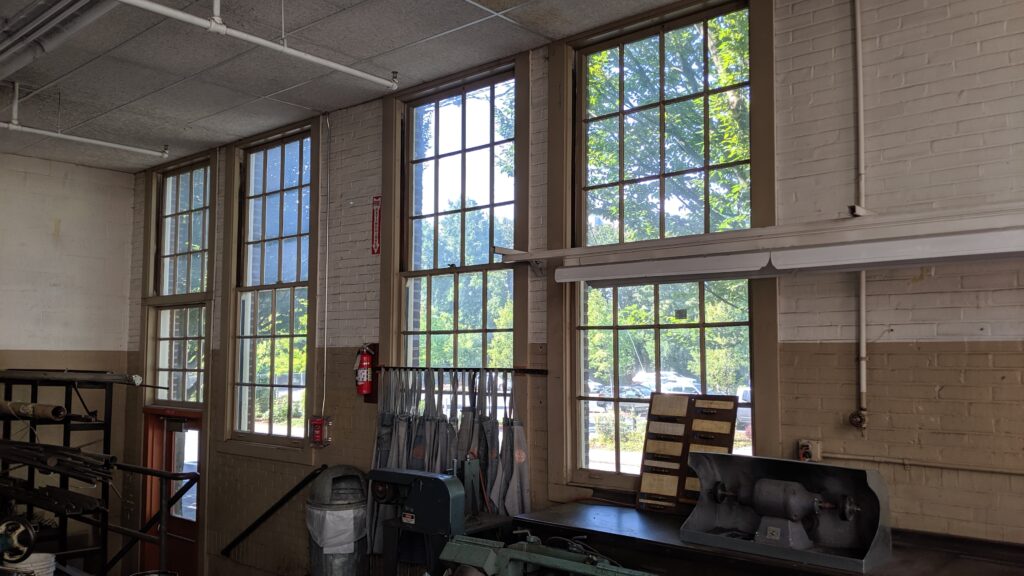
North-facing windows in a shop overlook street trees on NE Irving St. 
A manufacturing shop features numerous lathes. 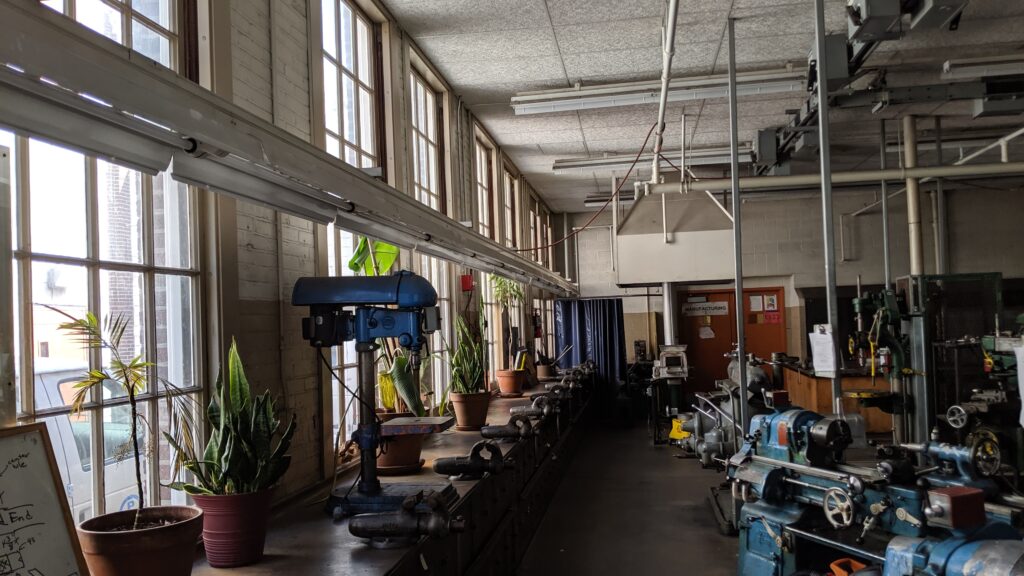
Manufacturing shop with windows to the single remaining original courtyard, between the north shop wings. 
A narrow courtyard separates the 1916 one- and two-story north shop wings. 
View from the foundry building across the courtyard to the north shop wing. 
The pattern-making shop in the foundry building. 
A student-built plaque for the foundry program. 
Mechanical ductwork fills an original single-loaded fan-light corridor now used as a storage room in the foundry building. 
Original brick wainscoting, picture mold, and fan-light window trim in a fragment of the original single-loaded passageway circulation system. 
The foundry. 
The foundry.
New Construction
As the Benson campus embarks on a three-year construction project, its surroundings are also changing. The Benson parking lot at NE Glisan & 16th will soon host a new three-story school building for PPS’ multiple pathways to graduation programs. A new apartment building is nearing completion across NE 15th from the KBPS building. When work is completed in 2024, the neighborhood and campus will feel new while celebrating 108 years of history.



Your pictures of Benson High School are amazing! Are you a graduate of Benson? I am.
My college is Reed College, also in Portland. Do you have any pictures of Reed? It is very photographic… I have some alumni class albums on the Reed site, and they are mostly pictures taken by students – but I look around for more. One of the albums is just for Reed architecture. So if you have any, and allow me to share them to these alumbi albums, it would be awesome!
Thanks,
Kevin
As a proud 1965 graduate of Benson, thanks for this wonderful trip down memory lane! The early history was as interesting to me as the wonderfully detailed pictures of Benson prior to the new (2021-2024) rebuild.
Just want to say thanks for the memories. I went to Benson in 1972 to 1975
was lots of hard work but had a really fun time as I was on the stage crew and got to work for who ever wanted to rent the auditorium at that time. playing movies at lunch time and building sets.
Thanks so much for the memories. Class of 1974.